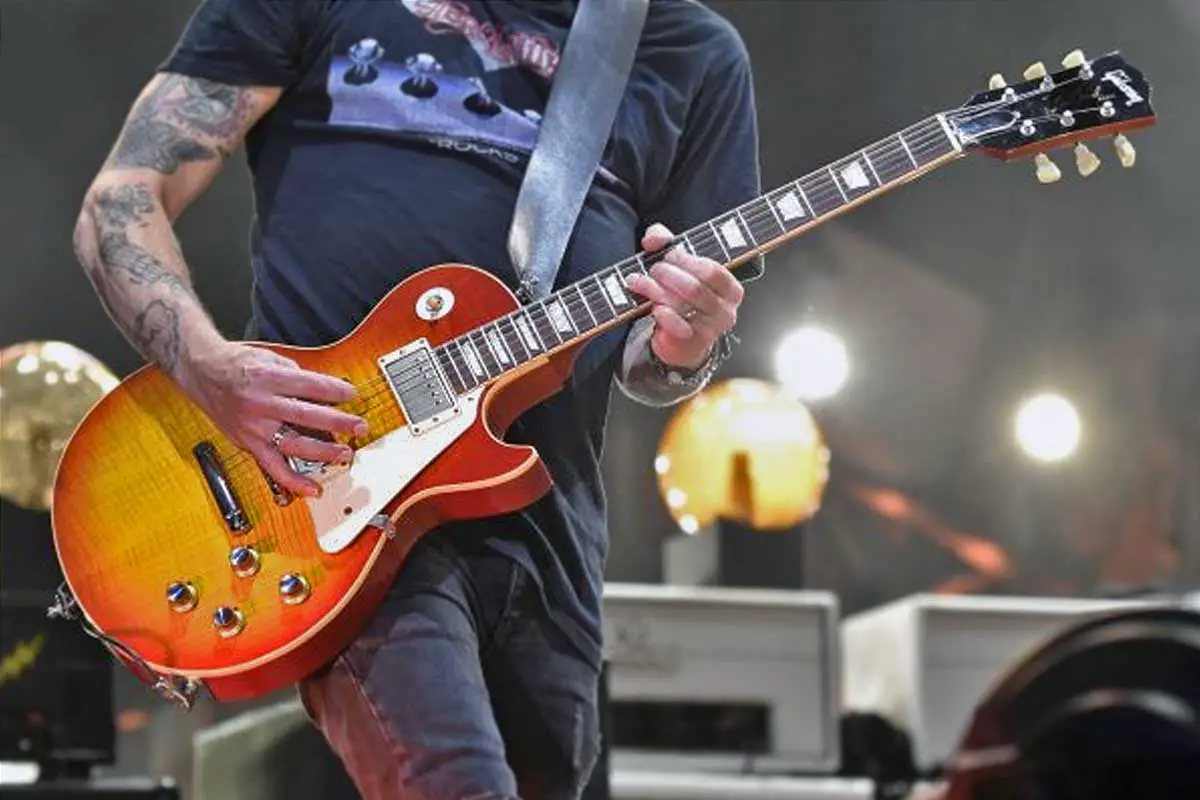D Standard Tuning, also known as D Tuning, is a variation of guitar tuning where each string is tuned down a whole step from the traditional E Standard Tuning. This means that the strings are tuned to DGCFAD, from the lowest to the highest string. This tuning creates a deeper, heavier sound that is favored in genres such as metal and hard rock.
While E Standard Tuning, defined by the pitches EADGBE, is widely used due to its balanced range and versatility across various music styles, D Standard offers a different tonal palette and can provide a thicker texture to the music.
It’s important to note that while D Standard Tuning changes the pitch of the guitar, it maintains the same relative string-to-string pitch intervals as E Standard, allowing guitarists to use familiar chord shapes and scales.

Comparing D Standard Tuning to E Standard Tuning
When comparing D Standard Tuning (DGCFAD) to E Standard Tuning (EADGBE), the most immediate difference is in pitch. Each string in D Standard is tuned down a whole step, resulting in a lower, deeper tone that can give a heavier and more resonant sound to the guitar. This down-tuning can affect the playability of the guitar as well; the reduced string tension can make fretting notes and bending strings easier, which may be beneficial for players with a lighter touch or those who engage in extensive bend-heavy solo work.
The suitability of D Standard Tuning often depends on the musical genre. It is particularly prevalent in hard rock and metal, where its lower pitch complements the aggressive and weighty sound that these genres often strive for. However, D Standard Tuning is not genre-exclusive and can be creatively applied to blues, jazz, and even classical guitar pieces, offering a unique tonal quality that can inspire new approaches to these styles.
The Benefits of D Standard Tuning
| Benefit | Description |
|---|---|
| Richer Tone | Provides a deeper, more resonant sound ideal for heavier music |
| Easier Playability | Reduced string tension allows for easier bends and vibrato |
| Creative Inspiration | Encourages experimentation with new sounds and techniques |
| Genre Versatility | Suitable for metal, rock, blues, and beyond |
| Familiar Finger Patterns | Maintains the same intervals as E Standard, allowing for easy transition between tunings |
How To Implement D Standard Tuning
To safely implement D Standard Tuning, it’s crucial to begin with the higher strings to avoid adding excessive tension to the lighter strings, which could cause them to snap.
Start by tuning your first string, the high E, down to D. Proceed to the second string, B, tuning it down to A. Follow with the third string, G, bringing it down to F. Once the higher strings are detuned, you can then tune the fourth string, D, to C; the fifth string, A, to G; and finally, the sixth string, low E, to D. You can use the tuner below to match your frequencies.
After tuning all strings, revisit each one to fine-tune, as the initial detuning may cause slight pitch fluctuations until the strings acclimate to the new tension.
- Tune the 1st string (high E) down to D
- Tune the 2nd string (B) down to A
- Tune the 3rd string (G) down to F
- Tune the 4th string (D) down to C
- Tune the 5th string (A) down to G
- Tune the 6th string (low E) down to D
- Double-check and adjust tuning as needed to compensate for settling strings
Standard D Tuner:
Please note that while the video demonstrates tuning to D Standard starting with the low strings, it is generally safer to begin tuning with the high strings first. This approach helps prevent the lighter, thinner strings from snapping due to increased tension when the thicker strings’ tension is reduced.
Artists Who’ve Made Songs In D Standard
D Standard Tuning lends a distinct depth and heaviness to the sound of a guitar, which is why it’s favored by many artists and bands, especially in the rock and metal genres. The following table lists notable musicians who have incorporated D Standard Tuning into their music, showcasing the tuning’s versatility and impact on their signature sound.
| Artist/Band | Notable Songs/Albums in D Standard |
|---|---|
| Metallica | “The Thing That Should Not Be” |
| Nirvana | “Come as You Are” |
| Mastodon | Various songs and albums |
| Death | Various songs and albums |
| Gojira | Various songs and albums |
| Pantera | “Walk” |
| Johnny Winter | Various songs in D Standard/Open D |
| Robin Trower | Various songs and albums |
| Adagio | “Inner Road” |
| All That Remains | Various songs and albums |
| Decapitated | Various songs and albums |
| Exodus | Various songs and albums |
These artists have explored the creative possibilities of D Standard Tuning, contributing to their unique sound and expanding the boundaries of their respective genres.

Maintaining DGCFAD Tuning Stability
Maintaining stability in D Standard Tuning (DGCFAD) requires careful attention to your guitar’s setup and the choice of strings. When selecting strings, opt for a set that accommodates the lower tension of D Standard without becoming too floppy—medium gauge strings are often a good choice.
Intonation adjustments are wroth noting; as you tune down, the length of the string may require fine-tuning at the bridge to ensure that each note is in pitch all along the fretboard.
Regular maintenance, such as checking the neck relief and ensuring your tuning machines are in good working order, will also contribute to your guitar’s tuning stability.
Keep in mind that a guitar set up for E Standard may not perform optimally in D Standard, so consider a professional setup if you plan to use D Standard Tuning frequently or long-term.
Helpful Tips for D Standard Tuning Stability
| Tip | Description |
|---|---|
| String Gauge For D Standard | Medium gauge strings (10s or 11s) can balance tension and playability in D Standard. |
| Intonation Check | Adjust bridge saddles to ensure accurate intonation across the fretboard. |
| Neck Relief | Monitor and adjust the truss rod to maintain optimal neck curvature. |
| Tuning Machine Maintenance | Keep tuning pegs lubricated and in good condition for smoother tuning. |
| Regular String Changes | Change strings regularly to prevent tuning issues related to worn strings. |
| Stretching New Strings | Properly stretch new strings to help them settle and maintain tuning. |

Other Alternate Tunings
Exploring alternate tunings can dramatically expand your creative palette and offer new textures in your guitar playing. From the deep growls of C Standard to the shimmering harmonics of Open D, each tuning brings its own unique flavor and challenges. Here’s a variety of alternate tunings, including their respective string configurations and distinct characteristics, to inspire your musical exploration.
| Tuning Name | Tuning (Low to High) | Characteristics |
|---|---|---|
| Drop D Tuning | D-A-D-G-B-E | Allows for quick and easy power chords using a single finger. |
| Open D Tuning | D-A-D-F#-A-D | Strings tuned to form a D major chord when played open; popular for blues and slide guitar. |
| Eb Standard Tuning | Eb-Ab-Db-Gb-Bb-Eb | All strings tuned down a half step; used for a slightly lower pitch while retaining standard intervals. |
| C Standard Tuning | C-F-Bb-Eb-G-C | All strings tuned down two whole steps from standard tuning; provides a very deep and heavy sound. |
| Drop C Tuning | C-G-C-F-A-D | Similar to Drop D but tuned down a whole step lower, allowing for heavier riffs. |
| Open F Tuning | F-A-C-F-C-F | Strings tuned to form an F major chord when played open; used for slide guitar and unique voicings. |
| 7 String Guitar Tuning | Varies | Typically adds a low B string (B-E-A-D-G-B-E), but tunings can vary widely. |
| 8 String Guitar Tuning | Varies | Adds two lower strings, often tuned to F# and B (F#-B-E-A-D-G-B-E), but can vary. |
| 12 String Guitar Tuning | E-A-D-G-B-E (octaves for E, A, D, G and unison for B, E) | Standard tuning, but with each string paired with a second string, one octave higher for the lower four pairs. |
Frequently Asked Questions
How do you tune a guitar in D standard?
The same way you would tune a guitar in E standard. Essentially it is the same format, however the pitch of the strings is 1 step lower.
Is D standard tuning drop D tuning?
No, D standard tuning affects all the strings being lowered in pitch by two semitones.
Dropped D tuning on the other hand, is basically standard E tuning but affects only one string, the low E string which is lowered by 2 semitones.
How do you remember D standard tuning?
If you already know the letters for E standard tuning (EADGBE), then simply replace each letter with the previous one in the alphabet. Just remember that the last note for music in general is G before restarting back to A. The result is DGCFAD tuning.
Why is drop D tuning so popular?
This configuration is popular in hard rock & various styles of metal because it allows for quick & easy power chords. Whereas basic power chords require 2 separate fingers, but when using Dropped D you only need 1.
What is D standard good for?
D standard tuning is useful when choosing to use thicker strings. Lowering the pitch by a whole step also lowers the tension of your strings which makes the thicker strings more comfortable to play.
What is the difference between drop C & D standard?
D Standard Tuning involves tuning each string of the guitar down a whole step from the standard E tuning, resulting in DGCFAD tuning. Drop C Tuning takes D Standard as a starting point and then lowers the 6th string (originally E, now D in D Standard) down another whole step to C, resulting in CGCFAD. This allows for heavier riffs and easier power chord shapes on the lower strings.
What are open tunings?
Open tunings are a sort of guitar tuning in which the strings are tuned to make a chord when played openly without the use of frets.
This means that when all strings are played together, depending on the tune, they generate a major or minor chord.
Open tunings can be utilized to create unusual sounds and chord voicings that would be impossible to achieve with standard tuning. They are frequently employed in slide guitar playing and can spark new songwriting ideas and tunes.
Conclusion
In conclusion, D Standard Tuning offers guitarists a rich sonic landscape, marked by a deeper, more resonant tone that can enhance the heaviness and depth of your music, particularly in genres like metal and hard rock.
The benefits of easier playability and familiar finger patterns make it an accessible alternative for those looking to explore beyond E Standard Tuning, while the challenges of maintaining tuning stability and adjusting your setup are easily navigated with a bit of care and knowledge.
Whether you’re a seasoned player or new to the guitar, D Standard Tuning is a valuable tool in your arsenal, encouraging experimentation and potentially unlocking new creative avenues. Embrace the opportunity to delve into this tuning, practice regularly, and you may find that it opens up a whole new dimension to your guitar playing.
